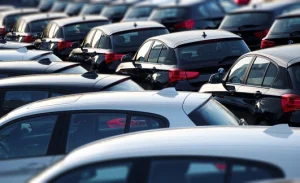The global automotive sourcing landscape has undergone a transformative shift, positioning China used cars as essential assets for competitive dealerships. As China cements its dominance in automobile exports – surpassing traditional manufacturing powerhouses – its secondary vehicle market delivers unprecedented value through technological sophistication, aggressive pricing, and diverse inventory. For dealers navigating evolving consumer demands and tightening margins, China used cars represent not merely an alternative supply channel, but a fundamental strategic realignment in the contemporary automotive ecosystem.
In this article, we will explore the five key reasons for used car dealers importing a used car from China.
Importing China Used Cars Cost Less
Direct Acquisition Cost Reduction
China Used Cars deliver extraordinary upfront savings, typically transacting at 30%-70% below new equivalents, with near-new models under three years offering the most pronounced financial advantages. This pricing revolution originates from China’s colossal manufacturing infrastructure, which produces 32% of global vehicles annually and saturates the secondary market with premium inventory. Consider the Nissan Sylphy’s pricing structure: while new units command $16,000-$21,000, three-year-old examples transact at just $8,000-$11,000, representing over 50% immediate savings. Similarly, the Volkswagen Passat demonstrates 40-50% depreciation within two years, moving from $25,000-$35,000 when new to $14,000-$20,000 as lightly used inventory.
Structural Tax Efficiency
Unlike new vehicles taxed on original manufacturer suggested retail price (MSRP), China Used Cars face levies based on residual valuations: Egypt exemplifies this disparity, imposing progressive 40-135% tariffs on new imports based on engine displacement, while applying a fixed 10-20% rate to pre-owned vehicles. The United Arab Emirates similarly differentiates between new cars facing 5% duty plus value-added tax (VAT) and used imports taxed solely on depreciated value. When importing a three-year-old Nissan Teana to Egypt, dealers achieve over 60% total cost reduction versus new equivalents, demonstrating how China Used Cars structurally enhance profitability through intelligent tax arbitrage.
China Used Cars Technological Innovation
Exclusive Model Portfolio
China Used Cars for export include domestically-engineered vehicles offering distinctive value propositions unavailable through conventional sourcing channels. The Honda Lingpai illustrates this advantage – designed exclusively for Chinese consumers, this compact sedan combines premium interior appointments with compact dimensions, transacting at just $8,000-$12,500 on the secondary market, making it an attractive option for second hand cars for export. Similarly, the Tank 300 off-roader delivers Land Rover-inspired capability at approximately 30% below international equivalents, positioning it as a competitive choice in the global used car export market. Dealers importing these China Used Cars gain immediate showroom differentiation while capturing customers seeking distinctive transportation solutions beyond mainstream offerings, further enhancing their export-ready used car inventory.
Electric Vehicle Leadership
China commands 60% of global electric vehicle production, positioning China Used Cars as technological ambassadors carrying cutting-edge innovation. Extended-range hybrids like the Li Auto L7 demonstrate remarkable value retention, maintaining over 85% residual value after twelve months of ownership due to proprietary powertrain technology. Li Auto models featuring blade battery architecture offer superior thermal safety compared to conventional lithium-ion packs. When purchasing a used car with warranty like the Li Auto L7 at $28,000-$35,000, approximately 50% below comparable Tesla Model Y pricing.
China Used Cars Value Preservation and Profit
Used Car Depreciation Mitigation
China Used Cars exhibit fundamentally different depreciation curves compared to new vehicles, creating inherent financial protection for dealers. New automobiles typically suffer 20-30% value erosion within their initial year – exemplified by the Toyota Levin plunging from ¥130,000 to ¥90,000-100,000 after twelve months. In stark contrast, three-year-old China used cars experience modest 5-8% annual depreciation thereafter. This phenomenon creates a strategic acquisition window where the steepest depreciation has already occurred, insulating dealers from catastrophic value loss while preserving inventory equity. The Li Auto L7 further demonstrates how technological distinction enhances value retention, with its unique extended-range powertrain maintaining over 85% residual value after one year.
Procurement Optimization
China’s automotive surplus creates exceptional negotiation leverage for volume importers of China Used Cars. Dealers procuring five or more units typically secure 5-15% volume discounts, while model bundling – such as combining Nissan Sylphy sedans with Toyota Levin compacts – unlocks additional savings. Flexible pricing structures allow meaningful negotiation, evidenced by Volkswagen Passats frequently transacting at ¥105,000-110,000 against initial ¥120,000 asking prices. These procurement efficiencies directly enhance gross margins while reducing capital commitment, delivering tangible answers to profitability questions surrounding Importing used cars from China.
Risk Mitigation of China Used Cars
Quality Assurance Protocols
Reputable exporters implement multi-stage verification processes ensuring every used car with warranty meets international standards. Comprehensive 200-point inspections evaluate mechanical integrity, electronics functionality, and structural soundness. Advanced diagnostics include paint thickness gauging to detect hidden repairs, compression testing for engine health verification, and flood damage detection through moisture sensors. These protocols transform perceived risk into competitive advantage, with certified China Used Cars consistently outperforming locally sourced inventory in reliability metrics.
Integrated Logistics Solutions
Importing China used cars leverages sophisticated export infrastructure minimizing operational friction. Documentation specialists prepare pre-cleared customs paperwork incorporating harmonized system codes and certificates of conformity. Roll-on/Roll-off (RO-RO) vessel operators optimize maritime routing, reducing China-to-Middle East transit to eighteen days. Destination services handle last-mile compliance including import licensing, port clearance, and in-country registration. This vertically integrated approach reduces delivery timelines by 30% compared to fragmented logistics models, accelerating inventory turnover for dealers sourcing China Used Cars.
Unique China Used Cars Export Strategies
Emerging Market Development
The Benefits of importing China used cars achieve maximum impact in developing economies. African importers leverage conversions for Kenya and Uganda, creating inventory priced 40% below Japanese equivalents. Middle Eastern dealers source premium SUVs like the Tank 300 at similar discounts to local pricing while offering superior equipment levels. Each deployment demonstrates how China used cars solve specific market challenges while expanding dealer reach.
Electrification Ecosystem Integration
Forward-thinking dealers transform China used cars into comprehensive mobility solutions through strategic partnerships. Collaborations with charging network providers enable bundled offerings including charging credits with EV purchases. Battery health certifications from manufacturer-affiliated technicians enhance consumer confidence in pre-owned electric vehicles. Proactive engagement with municipal authorities secures access to green vehicle subsidies, low-emission zones, and parking incentives. This ecosystem approach maximizes returns on electric China used cars.
Why CAR Field is Top Used Car Exporter in China
CAR Field dominates China used cars export market by leveraging unique structural advantages. Parent company CAR Inc. secures new vehicles at 22% below retail via bulk purchases (10,000+ units annually), deploying them for 18-24 months in rentals before channeling them to CAR Field with >75% residual value. This model enables prices 15-30% below competitors.
Supported by 20+ years of export expertise, 130+ showrooms, and 5,000㎡ warehouses, CAR Field ensures global-ready quality through rigorous 182-point inspections and comprehensive warranties. Our infrastructure enables reliable worldwide delivery of premium luxury vehicles in “ready-to-sell” condition, eliminating dealer reconditioning time. We further differentiate through customized solutions – including specific model sourcing, modifications, and VIP treatment – complemented by competitive pre/post-sale support. This end-to-end approach guarantees client satisfaction while maximizing dealer profits through both cost savings and operational efficiency.
Conclusion
China Used Cars represent the automotive industry’s most significant sourcing innovation, converging cost efficiency, technological sophistication, and market adaptability into a singular strategic opportunity. With China exporting over five million vehicles annually, this supply channel transcends inventory procurement to enable fundamental business transformation. Dealers partnering with certified exporters secure:
✅50-70% acquisition cost advantages versus new equivalents
✅Exclusive access to EV and connectivity technologies
✅ Built-in depreciation buffers protecting working capital
✅Customization capabilities creating market-specific advantages
The critical question evolves from “Is it profitable to import second-hand cars from China?” to “How rapidly can your dealership integrate this supply chain before competitors establish dominance?” China Used Cars provide the foundation for sustainable dealership growth throughout this decade and beyond.



